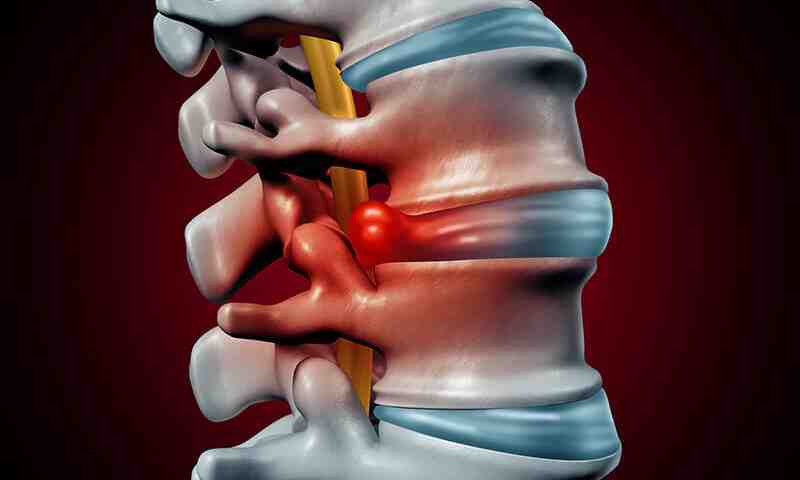Exactly What is a Disc Bulge?

Recent Advances in Alzheimer’s Disease and Treatments
January 15, 2024
Post Traumatic Headaches.. What Are They?
February 5, 2024F.A.Q.: What is a disc bulge?
Dr. Deryk Harting, a member of one of the highest rated auto injury medical facilities, Chambers Medical Group, discusses spinal discs and the differences between a disc bulge and disc herniation. A spinal disc, also known as an intervertebral disc, is a soft, rubbery cushion located between the vertebrae of the spine. The spine is composed of individual bones called vertebrae, and the spinal discs are situated between each pair of vertebrae. These discs play a crucial role in providing flexibility, absorbing shock, and allowing movement in the spine.
The structure of a spinal disc consists of two main parts:
- Annulus Fibrosus: This is the tough, outer layer of the disc composed of collagen and proteins called lamellae. It surrounds and encases the inner core of the disc.
- Nucleus Pulposus: This is the soft, gel center of the disc. It contains a jelly-like substance that provides flexibility and strength to the spine.
The spinal discs serve several important functions including:
Shock Absorption: They absorb shock and distribute pressure, allowing the spine to withstand compression and maintain its flexibility.
Flexibility: The discs contribute to the spine’s ability to bend, twist, and move in various directions.
Spacing: They help maintain the space between vertebrae, preventing them from rubbing against each other or on the nearby exiting spinal nerves.
Due to injury or with aging over time, the discs may undergo changes such as degeneration, dehydration, bulging, or herniation, which can lead to various spinal issues and symptoms. Car accidents can also have a significant impact on the spine and may affect spinal discs in various ways. The forces generated during a car crash can lead to tearing or damage of the disc’s outer layer as well as other spinal injuries. Some of these forces include whiplash, compression, shearing/twisting, direct trauma, rapid acceleration, and rapid declaration.
What Is A Disc Bulge?
A spinal disc bulge, also known as a disc protrusion, occurs when the outer layer of a disc (annulus fibrosus) dehydrates and weakens as the cartilage stiffens. A bulging disc affects at least 25 percent or more of the disc’s total circumference. Only the outer layer of tough cartilage is involved. A bulging disc can happen in any part of the spine but is more common in the lower back.
It is important to note that not all disc bulges cause symptoms and some people may have them without even realizing it. However, if a bulging disc is pressing on nerves or causing other issues, it may cause pain and symptoms which require medical attention.
What Is A Disc Herniation?
A spinal disc herniation, commonly referred to as a herniated disc, ruptured disc, or slipped disc occurs when the soft inner material (nucleus pulposus) of a spinal disc leaks through a tear or rupture in the outer layer (annulus fibrosus). Although they are referred to as a slipped or ruptured disc, only a portion of the disc’s circumference is affected. When a disc herniates, the inner material can press on nearby nerves leading to symptoms such as pain, numbness, tingling, or weakness. Herniation may also cause inflammation and irritation of the surrounding structures. Disc herniations often occur in the lower back and the neck but can also happen in the middle back.
Common causes of disc herniation include age-related wear and tear, trauma, injuries, twisting motions, and improper lifting technique. Symptoms can vary depending on the location of the herniation and the nerves affected.
A herniated disc is more likely to cause pain compared to a disc bulge because it usually protrudes farther and is more likely to irritate nerve roots. The irritation can be from compression of the nerve but more commonly the herniation causes painful nerve root inflammation.
It is essential for individuals experiencing symptoms of a herniated disc to seek medical attention for a proper diagnosis and an appropriate treatment plan tailored to their specific condition. Diagnosis and treatment of spinal disc injuries often involve imaging studies such as CT scans or MRI scans, and may include conservative measures like rest, chiropractic care, physical therapy, or pain management. In more severe or non-responsive cases, surgical intervention may be possible. Early intervention and customized care strategies are key to helping manage symptoms and improve outcomes for individuals with spinal disc injuries.
— This article is written by Deryk Harting, DC, one of the members of Chambers Medical Group’s team of car accident chiropractors who offer a variety of treatments and therapies ranging from diagnostic testing to various soft tissue therapies for car accidents and injuries in Florida.
–
.
–
Have you been in a car accident? If you or somebody you know has been in a car accident, be sure that you seek medical attention from a car accident doctor or car accident chiropractor to treat your injuries. Visit Chambers Medical Group to receive world-class medical treatment for your injuries.
Chambers Medical Group has car accident medical clinics in the following locations:
- Car Accident Medical Clinic in Tampa
- Car Accident Medical Clinic in Plant City
- Car Accident Medical Clinic in Brandon
- Car Accident Medical Clinic in Lakeland
- Car Accident Medical Clinic in Sarasota
- Car Accident Medical Clinic in Louisville
- Car Accident Medical Clinic in Lexington
- Car Accident Medical Clinic in Florence




